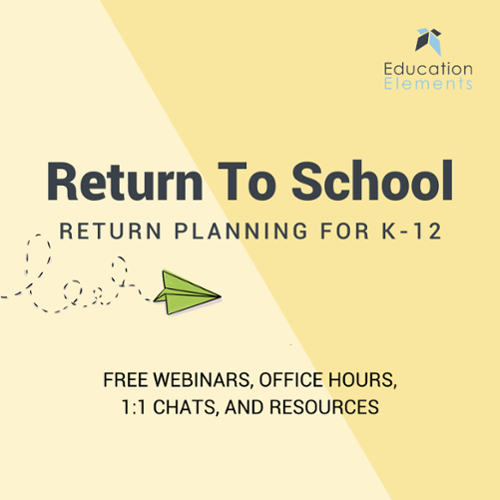I’ve written several blog posts and admittedly, this has been one of the harder ones. On the one hand, it’s important to share strategies at a time like this. On the other hand, I haven’t found a ton of equity strategies to share. I struggled with this dilemma and even considered shelving the post entirely. However, that struggle led to (1) a recognition that this conversation is just as critical as ever to have and (2) some important understandings, including:
- The equity strategies we have are built for brick and mortar schooling.
- Addressing equity related to virtual learning requires constant iteration.
- Districts are already innovating on common equity strategies.
The equity strategies we have are built for brick and mortar schooling.
While education has the power to address some of the causes of inequity, schools are often designed to address the effects of inequity. Schools create schedules that allow students to receive extra instruction. Educators are hired to support students in school; whether that is in classrooms, counseling offices, lunchrooms, or through intervention. There are entire systems built around addressing inequity, and those systems operate almost exclusively in school buildings. When we are forced to close our brick and mortar buildings, those systems cease to function because they were never designed to function outside of those buildings.
Recognizing this reality is not meant to stifle our resolve, rather it should be a call to action. We must design new systems and strategies to address the equity issues presented by virtual learning. And we must constantly look for opportunities to iterate on those systems and strategies. It took decades to design systems to address equity in our schools; we shouldn’t assume that the first version of any system we design today will be the last.
Addressing equity related to virtual learning requires constant iteration.
Schools and districts are scrambling to implement virtual learning as the COVID-19 pandemic spreads. The practices to address equity are a critical part of those plans and it is important to consider those practices as version 1.0. Addressing equity issues should be an ongoing priority. Simply distributing devices to students is not the last step. Teams should be constantly looking at data; talking with students, families, and teachers; and reflecting on current practices to determine the best way to support all students. The NEW School Rules suggests that, "When planning is open, iterative, and relieved of the need for perfection, each person is empowered to take actions that are responsive to the current reality." Our current reality is unprecedented, and it will take our collective skills and expertise to meet these new challenges head-on.
Districts are already innovating on common equity strategies.
- Use meal distribution centers to share work packets: The Syracuse City School District (SCSD) is using their student meal pick-up sites to distribute food and work packets to students. Food security has been a central equity topic for districts. SCSD has set-up 34 meal pick-up sites at school and community locations across the city. Students can not only pick up their meals but they can get work packets at those sites as well.
- Student internet access is at the forefront of planning: Planning for virtual learning requires schools to ensure all students have equal access to lessons and materials. Dallas Independent School District is “...provid[ing] all secondary students a laptop or tablet for temporary use.” Several internet providers (Comcast, Cox, Charter) are also giving limited free and/or reduced-price service for low-income families who have a school-aged student(s). Many other districts, recognizing the challenges of virtual learning, are turning completely to no-tech alternatives, such as distributing books, textbooks, and work packets.
- Empower family members to support virtual learning: Families are a critical partner to ensuring that students are successfully learning at home. Many districts, such as DC Public Schools, are communicating with families in multiple languages. Schools are also considering offering virtual office hours to family members supporting learning at home. This is a critical move as families shoulder more of the responsibility of facilitating learning.
We recognize that these are only a few of the strategies that educators are pursuing and that there are a host of other important issues we haven’t addressed. As educators develop new strategies and continue to iterate on their current ones, we encourage teams to share as much as possible. What lessons did you learn from successes and failures? What would you have done differently if you were to approach this again? What should your peers across the country keep front of mind as they’re iterating on their strategies? More than ever, we must rely on our collective wisdom as we continue to support all our students and families.
To support districts and schools, we have a series of webinars, 1:1 office hours, drop-in chats, and other resources for educators navigating the impact of the COVID-19 pandemic on equity and access, teaching and learning, staff retention, district culture, strategic planning, learning technologies, and leadership practices. Learn best practices from experts, discuss challenges with other districts and leaders like you, and find community with other education leaders.





